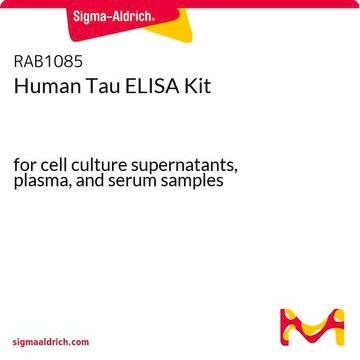GS05
GST S1-1, Recombinant Human
Synonim(y):
GSTS, GSTS1, PGD2, PGDS, hematopoietic prostaglandin D synthase
Zaloguj sięWyświetlanie cen organizacyjnych i kontraktowych
About This Item
Kod UNSPSC:
12352200
NACRES:
NA.26
Polecane produkty
pochodzenie biologiczne
human
Poziom jakości
rekombinowane
expressed in E. coli
Próba
>95% (SDS-PAGE)
Postać
frozen liquid
aktywność właściwa
24.07
masa cząsteczkowa
23 kDa
stężenie
0.9 mg/mL
temp. przechowywania
−70°C
informacje o genach
human ... HPGDS(27306)
Opis ogólny
using spectrophotometric determination of 1-fluoro-2,4-dinitrobenzene (FDNB) conjugation with reduced glutathione (1 mM) in 100 mM NaPO4 (pH 6.5) at room temperature.
Działania biochem./fizjol.
Glutathione S-transferase sigma 1, also know as hematopoietic prostaglandin D synthase (HPGDS) is an enzyme that in humans is encoded by the HPGDS gene. Glutathione S-transferases (GSTs) are a family of enzymes that play an important role in detoxification by catalyzing the conjugation of many hydrophobic and electrophilic compounds with reduced glutathione. Based on their biochemical, immunologic, and structural properties, cytosolic and membrane-bound forms of glutathione S-transferase are encoded by two distinct supergene families. At present, eight distinct classes of the soluble cytoplasmic mammalian glutathione S-transferases have been identified: alpha, kappa, mu, omega, pi, sigma, theta and zeta. The GSTs are thought to function in xenobiotic metabolism and play a role in susceptibility to cancer, and other diseases.
Prostaglandin-D synthase is a sigma class glutathione-S-transferase family member. The enzyme catalyzes the conversion of PGH2 to PGD2 and plays a role in the production of prostanoids in the immune system and mast cells. The presence of this enzyme can be used to identify the differentiation stage of human megakaryocytes.
Przechowywanie i stabilność
The enzyme should be used by the end-user customer within 1 year of receipt.
This page may contain text that has been machine translated.
Kod klasy składowania
10 - Combustible liquids
Klasa zagrożenia wodnego (WGK)
WGK 1
Temperatura zapłonu (°F)
Not applicable
Temperatura zapłonu (°C)
Not applicable
Certyfikaty analizy (CoA)
Poszukaj Certyfikaty analizy (CoA), wpisując numer partii/serii produktów. Numery serii i partii można znaleźć na etykiecie produktu po słowach „seria” lub „partia”.
Masz już ten produkt?
Dokumenty związane z niedawno zakupionymi produktami zostały zamieszczone w Bibliotece dokumentów.
Marcus Kjellander et al.
Analytical biochemistry, 446, 59-63 (2013-10-26)
The previously uncharacterized Drosophila melanogaster Epsilon-class glutathione transferases E6 and E7 were immobilized on nanoporous alumina. The nanoporous anodized alumina membranes were derivatized with 3-aminopropyl-triethoxysilane, and the amino groups were activated with carbonyldiimidazole to allow coupling of the enzymes via
Morten Hohwy et al.
Journal of medicinal chemistry, 51(7), 2178-2186 (2008-03-18)
We describe the discovery of novel inhibitors of prostaglandin D2 synthase (PGDS) through fragment-based lead generation and structure-based drug design. A library of 2500 low-molecular-weight compounds was screened using 2D nuclear magnetic resonance (NMR), leading to the identification of 24
Tsuyoshi Inoue et al.
Journal of biochemistry, 135(3), 279-283 (2004-04-29)
Hematopoietic prostaglandin (PG) D synthase (H-PGDS) is responsible for the production of PGD(2) as an allergy or inflammation mediator in mast and Th2 cells. We determined the X-ray structure of human H-PGDS complexed with an inhibitor, 2-(2'-benzothiazolyl)-5-styryl-3-(4'-phthalhydrazidyl) tetrazolium chloride (BSPT)
Brigette L Tippin et al.
Prostaglandins & other lipid mediators, 97(1-2), 22-28 (2011-08-09)
Intestinal tumors in Apc(Min/+) mice are suppressed by over-production of HPGDS, which is a glutathione transferase that forms prostaglandin D(2) (PGD(2)). We characterized naturally occurring HPGDS isoenzymes, to see if HPGDS variation is associated with human colorectal cancer risk. We
Nasz zespół naukowców ma doświadczenie we wszystkich obszarach badań, w tym w naukach przyrodniczych, materiałoznawstwie, syntezie chemicznej, chromatografii, analityce i wielu innych dziedzinach.
Skontaktuj się z zespołem ds. pomocy technicznej







